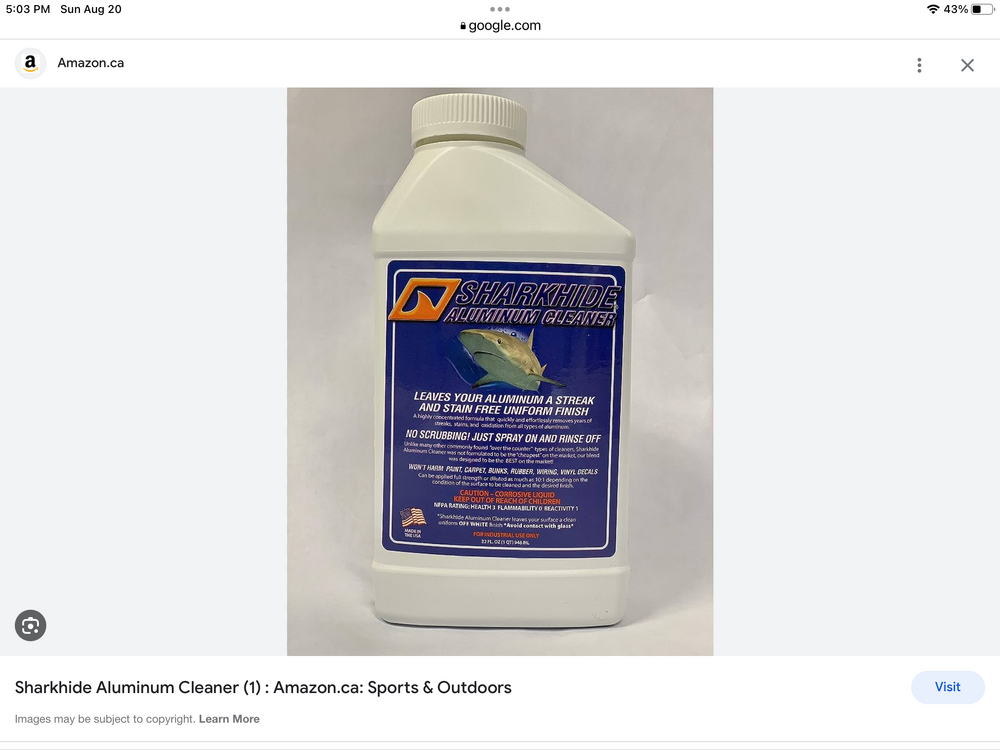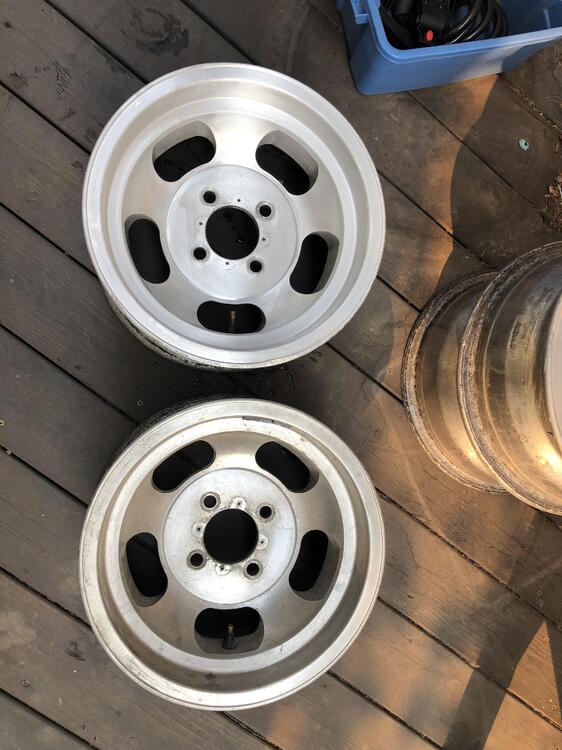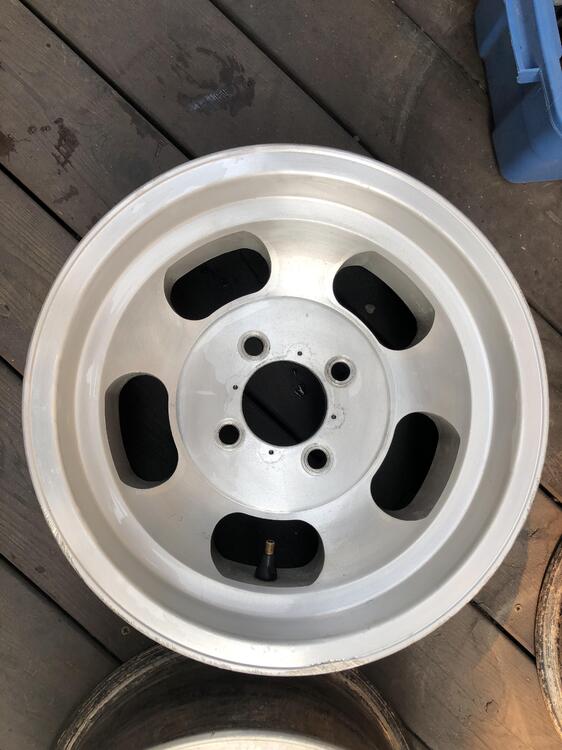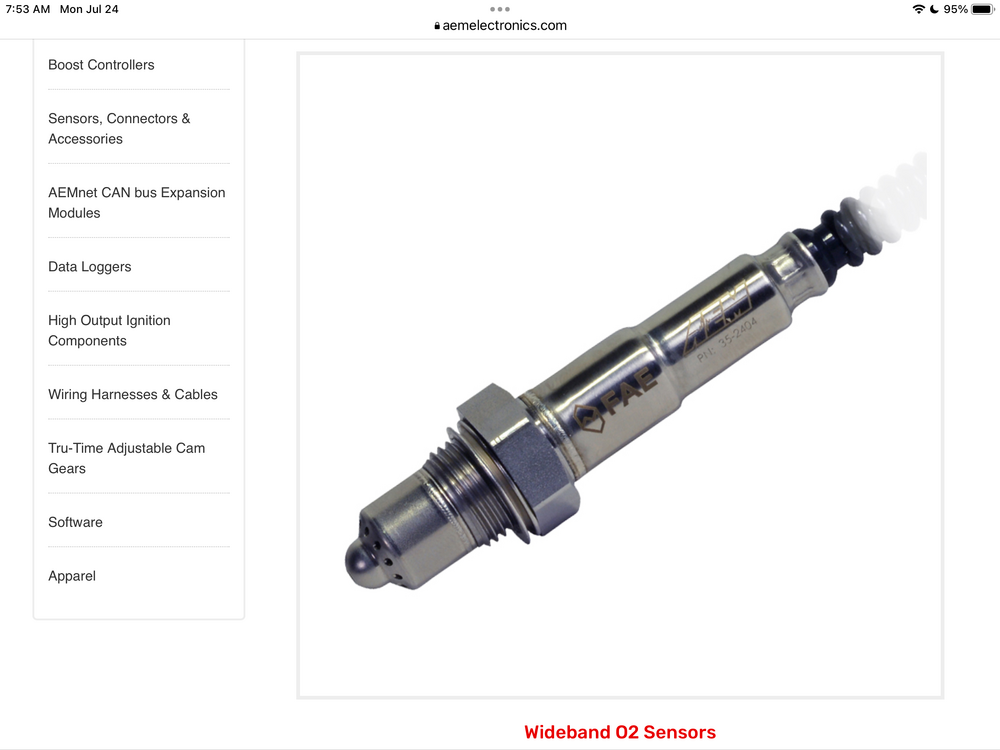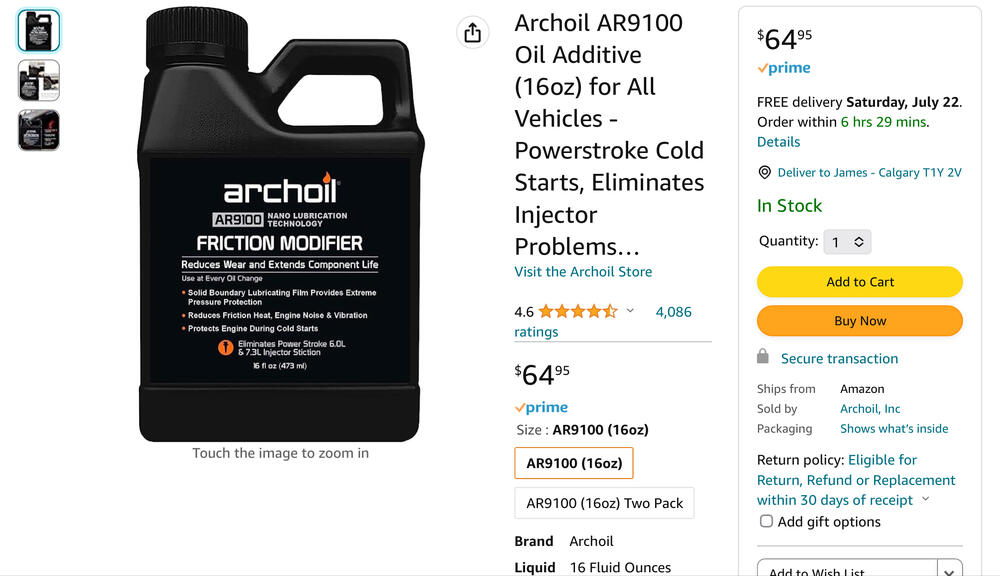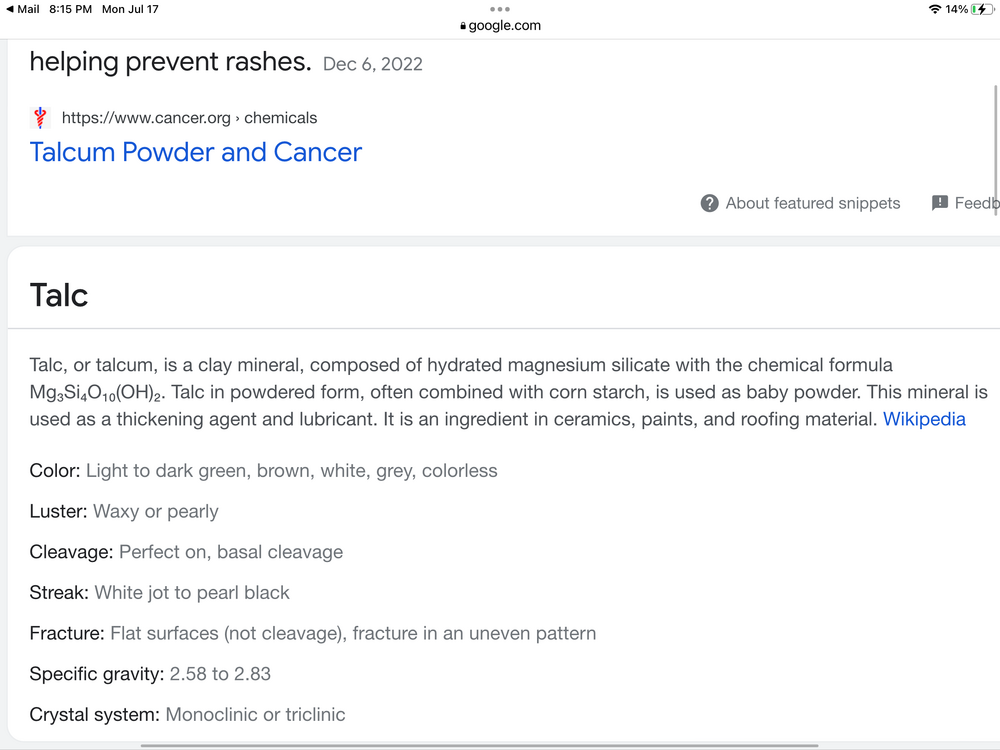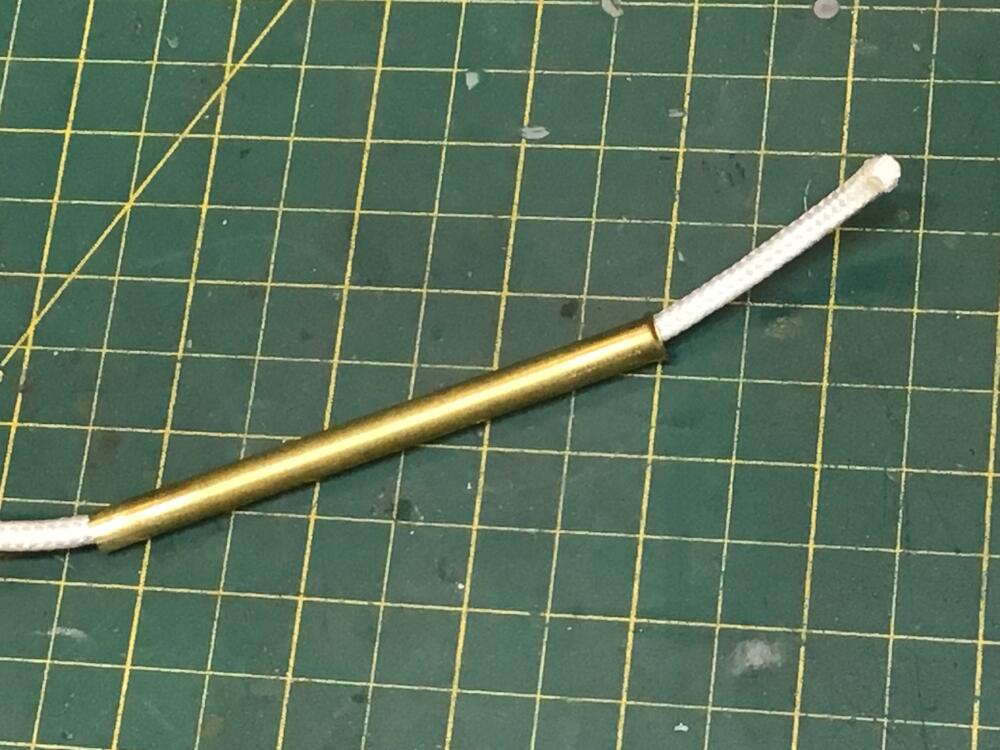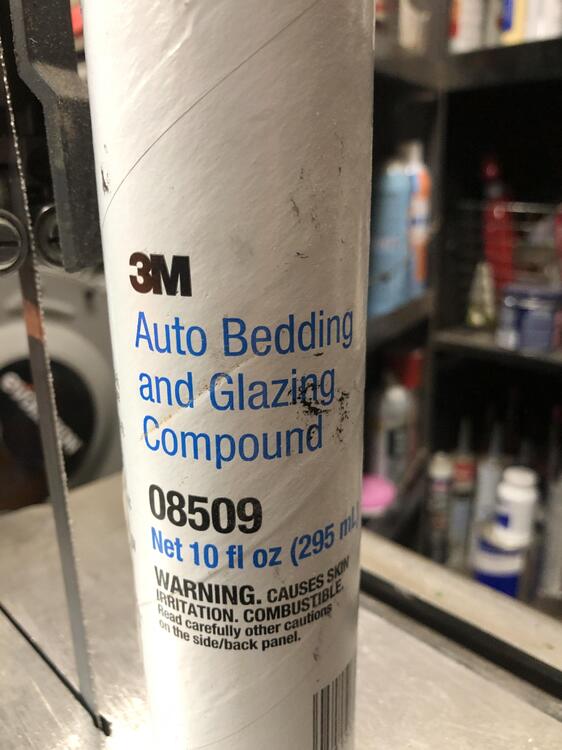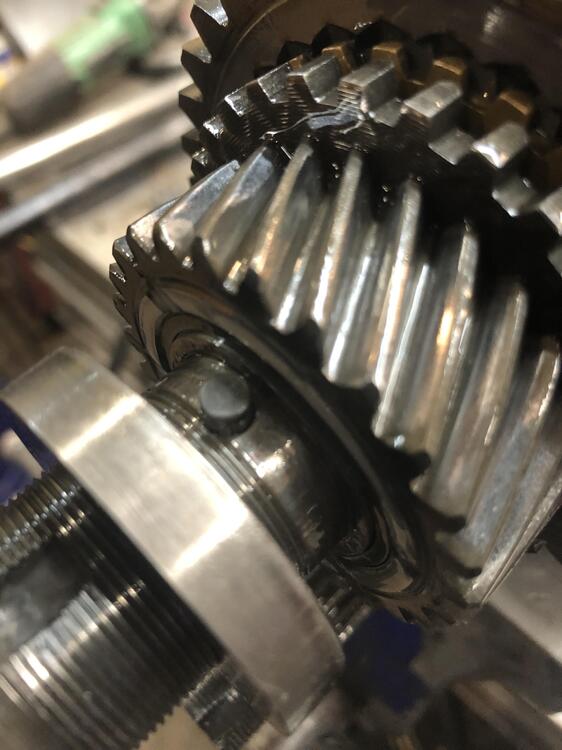Everything posted by zKars
-
Cleaning Western Wheels
-
Cleaning Western Wheels
I bought a product called SHARKHIDE several years ago with the intent to clean many aluminum Datsun things like wheels and valve covers. Finally got around to trying it today. THIS SHEITE IS DA’ BOMB! I have a set of lovely original D-slot mags on a 71 that I’m restoring, and this stuff took them from grim to perfect in the fastest easiest way I’ve ever imagined. This stuff is seriously bad for you, the instructions have scared me away from even trying it until today, but damn, it does what it says it will do. Just ragged it on, scrubbed the grime with same gray scotchbrite scrub pads then rinsed it off. 15 min per wheel tops. Obviously you have to the clear coat off first, not sure these ever had any. At the time I bought it, 10 years I think, it was only available thru boating companies, no retailer would ship it, so I picked up a bottle in Salmon Arm BC on the way back to Calgary on vacation that year. Now I see it on Amazon of course. I’d buy it from sharkhidestore.com, it’s $29.95 a quoart vs $97 on amazon, big surprise. If you want serious power, this stuff is what you want. Just be dang careful with it.
-
Triple Webers setup
Weber's have an accel pump jet that sprays fuel in the bore when you push the pedal. Little jet that sticks down in the bore from the top. You can get reversed weber choke mechanisms as well. I mean "inverted". One example https://www.mecatechnic.com/en-GB/choke-mechanism-for-weber-dcoe-and-idf-inverted_UC40223.htm
-
Beware AEM AFR Sensor kits with Fake Failure prone Bosch Sensors
I agree. Time to find a better alternative. Even their pictures on the amazon page that show various shots of the equipment, shows one with the Bosch sensor, and one with the fake. During one of my discussions with AEM, they said “whatever is shown on our website is exactly what you get” and they had inconsistent pictures then as well. Just looking today they show a clearly non-bosch sensor FAE brand, and bosch depending on where you look. To be fair, I purchased their 30-0319 X series controller for use in my latest EFI project and it came with a Bosch sensor, and has been working great all summer. It’s the one that just has the little controller box inline, no gauge, and you use it’s CAN bus (or analog) output to feed into your ECU for AFR data. I have also purchased stand alone Bosch sensors from Amazon and gotten the real thing at a decent price. This is typically what I buy to replace the shitty AEM sensor.
-
Beware AEM AFR Sensor kits with Fake Failure prone Bosch Sensors
So lets show the real vs fakes. Here are the two business ends. Bosch on the left, fake on the right. The Bosch sensor has that graduated heat coloring, a zip tii holding the sheath material over the accordion boot. The fake is shiny polished. And has no markings. The Bosch sensor has the markings you'd expect Lastly the wiring length of Bosch sensor is much longer.
-
Beware AEM AFR Sensor kits with Fake Failure prone Bosch Sensors
I have been bitten several times now (you'd think I'd learn...) by oxygen sensors that fail in the first few hours of life. I typically buy the AEM 30-4110 kit from Amazon, good price, shows up quick, blah blah. After a few rapid sensor failures, and me telling AEM, and them quickly sending new sensors under warrantee, and me going and buying "real" (more real??) Bosch sensors, I now have some details to report so you can determine if you get similar "bad" sensors.
-
Beware AEM AFR Sensor kits with Fake Failure prone Bosch Sensors
I have been bitten several times now (you'd think I'd learn...) by oxygen sensors that fail in the first few hours of life. I typically buy the AEM 30-4110 kit from Amazon, good price, shows up quick, blah blah. After a few rapid sensor failures, and me telling AEM, and them quickly sending new sensors under warrantee, and me going and buying "real" (more real??) Bosch sensors, I now have some details to report so you can determine if you get similar "bad" sensors.
-
Lean times, and not just because of high prices and low wages.
There. See? It was the loose dizzy cap. Guess it went wonky (sorry for the technical term) above 4k. I knew if I asked you guys would help me solve it! Even if only in spirit..... So what did we learn today? -Misfires can cause a lean condition as read on the AFR gauge, just like the reverse. -Change a bunch of stuff and get the same result? You are changing the wrong stuff. -Tunnel vision is blinding.
-
Lean times, and not just because of high prices and low wages.
Hmmmmm. I wonder if a loose and floppy distributor cap could have anything to do with it. Can a spark mis-fire read lean just like lean can cause a mis-fire?
-
Lean times, and not just because of high prices and low wages.
Ok, I'm having a bad week with nice stock L24 with SU's. Runs fantastic until you get over 4-4.5K RPM, then it leans out and misfires. Facts and Observations SM needles (been trying several others....) Four screw early carbs. Fresh and minty. New AEM AFR gauge in the exhaust. Never leave home without it. AFR's 13-14 around town below 4K RPM, car pulls like crazy super smooth 800 RPM smooth idle, but crawls up to 15-16.5 or higher and misfires when you get over 4K. Doesn't fall on its face, just gets rough running and power falls off and has trouble getting to 6k RPM. Fuel deliverability confirmed. NOS stock pump and then with an NOS electric pump (mechanical out of the circuit), both behave the same way. Both produce buckets full of fuel when I free flow them into, well, a bucket. Float level confirmed. Was a tad low, now perfect. No change in behavior before or after. yes there is oil in the domes. If I pull the chokes on and get the jet tubes down 1/8 then it runs better and the AFR's stay near 15, but turning the mix screws down to 5 or 6 turns to get that same result makes the idle-4K range pig rich and awful. No surprise there. Not a solution. Tried another set of SM needles, (these dang things are typically too rich on a stock L24!!! Not this time) same thing. Valve adjust and vacuum are normal. NGK BPR^ES usual at 0.036. All 6 look identical and lean-ish after a few hard pulls. I'm about to start sanding down the lower half of a set of SM needles to try to get it richer up top. Not easy to tell where to start sanding. Suggestions? What am I missing?!?!?!?!?
-
Possible method for improving synchro performance
Toss your tranny in the mail, I put some fresh synchro’s in. Never look back. Or learn to double clutch! I even threw in some ARCHOIL in the last transmission to see if it would improve the noise level. Didn’t help.
-
Possible method for improving synchro performance
-
Center Console Install/Hardware
Not much magic here, the three trapped nuts in the mounting brackets at the back are M5x0.8 thread, the bolts are black nearly flat headed phillips (ok, yes, JIS…) about 16mm long, The front two on the sides are self taping metal screws, now what size is a bit of a trick to describe, they thread into spring clips on the sides of the mounting bracket, something akin to #8 wood screws. They were oval headed, but whatever sits flush and doesn’t catch your knee…..
-
Replacement Windshield Options
I suspect talcum powder is 99% corn starch. I know Johnson’s Baby powder is. Corn starch is $1 per pound, any commercial product like talcum or Baby powder is 10x the cost. Nope, talc is something different. “Often mixed with corn starch….”
-
Replacement Windshield Options
Excellent write up. If I may add a couple of personal experience notes. 1. Putting the cord in the groove. I use a short piece of brass tubing, 1/4 OD or something, 4 inches longish, whatever will let your cord of choice pass through easily. Poke the end of the tube into the groove and drag it along, it will deposit the cord in the groove like magic. Should take you literally 30 seconds to do the entire circumference. 2. Lube. Tried all kinds of wet lubes, none were all that useful. If you feel compelled to use lube, try corn starch. Dry, stays put, cheap, easy clean up (blows away without doing anything actually) and makes rubber slippery without being greasy or drys out like soap. 4. Spend more time than you think you should getting the gasket/glass sitting as low and close into the window channel as you can, flush with the body all around, and centered left right. This will ensure an easy cord pull as the rubber lip is nice and close to the pinch weld. 3. Biggest trick of all is to use two cords instead of one. Start one top center and go around left, end at bottom center. Same for the right. Leave a foot at each end top and bottom. Pull a bit of the bottom, left and right six inches, then repeat on the top, left and right, continue left and right, balancing your pull top and bottom. Go around bottom corners first, then the top, though it really doesn’t matter. Why is this such a great deal? Balance. All the problem I had during the first dozen installs revolved around gravity. I always started at the pull at the bottom and ended at the top, if I went the other way, gravity would pull down and make the bottom sit far too far away from the pinch weld. At least if you set the bottom first, then the top is likely to stay closer. Still by the time you get around the top corners 3 of the 4 sides are in, and the top “tends” to be farther away from the pinch weld than is ideal and you end up fighting to get that rubber lip over the pinch weld. If you do the top and bottom at the same time, you have balanced gravity and trap the glass top and bottom, which are also the longer edges, so by the time you get to the sides, it’s all over but the beer drinking. You can also see if you’re slightly off center left/right before you do the sides, and have a chance of easily pushing it back out to start over. You do NOT want it off center of course. Leads to leaks. Bad enough that most seals I see don’t have molded bottom corners. Rubber never seems to sit right often exposing those bottom corners. Sealant time. See the picture below of what I use. Doing this balanced technique, I often don’t need a second person pushing on the glass from the outside. As long as ensure you get the glass/gasket down as tight to the body as possible before you start and maybe get out a couple of times to push it down as you get going around the top, or just before you start going around the corners. If you’re a social person, then get four buddies, one on each corner and you’ll be done in 5 minutes. 4. Setting the lip over the pinch weld. As you pull cord and the rubber lips slips over the pinch weld, I spend a few moments pushing the lip firmly down onto the pinch weld, seating it more completely than just where ever it sits after the rope passes that point. Makes double sure the glass is pulled down into place. I use a flat plastic tool to get between the glass and lip and press the lip away from then down over the pinch weld. I use a 5/32 white nylon cord, but I like the idea of thick string trimmer cord. Should have less friction. Whatever you use, wear thick leather gloves so you can pull without pain. Too old for that grin and bear it crap.
-
Replacement Windshield Options
No I never did get the SummitRacing ordered windshield I got lucky here, another Datsun guy that specialized in 510's worked out a deal with a US Pilkington rep years ago and was having batches of 10 windshields for Z's and 510 brought up to a local glass shop. He has moved on and I have now taken up that function. I still have about 5 of each in stock for local users. I'm getting really good at doing Z and 510 windshields now. His information was that virtually ALL auto glass is now made in one of two Chinese factories. I have seen differences in thickness, and one windshield was noticeably undersized when I installed it, but that's about it. The factory codes on all the glass show it made in the same specific factory in China. BTW And I have NEVER EVER broken a front or back glass while removing it. I remove the weather stripping face first with a HB olfa blade (flat to the glass) then just tap and push until it comes free. I've had cases where I've thrown old windshields and hatch glass in a dumpster hoping for the big crash and been disappointed as it just landed flat and intact. I'm sure it was laughing at me. I have not been brave enough to attempt a removal of a windshield whose weatherstripping is new and soft enough to flex and remove. I know that is a technique, it just never has come up enough that I had to learn it. Someday.
-
FS5W71B Transmission Failure. How and Why
Cap’N thanks for the excellent thought process, yes, hard to say what caused what. So plainly I should weld the nut to the main shaft AND them both to the washer, and nothing bad can happen. Right? Anyone want to buy a slightly used 5 speed?
-
FS5W71B Transmission Failure. How and Why
I plan to spot weld the big nut to the big washer to prevent it from turning, effectively duplicating the function of the ball. Drilling the main shaft for the later 5mm pin upgrade is not possible due to incredible hardness of the main shaft. I had to re-surface both the washer and the face of the gear it touches (sand them flat) in order to get them to turn freely when the nut is torqued. Both were a bit chewed up but there is virtually no clearance when tight. Just enough for an oil film. Can’t let any defects remain that can get the fit in trouble again. Regarding the possibility that a too-small ball was used when I replaced it, well it’s possible. If I lost that ball and replaced it with another, but my replacements are the “same” size within measureable limits. Seems the presence of a bit of rust and slightly loose nut allowed that washer to turn under the tremendous torque of a mighty L series and caused the deformation that turned into a lock up. Only guess I have at the moment.
-
FS5W71B Transmission Failure. How and Why
And of course we will speculate endlessly about what caused this in the first place. Notice the presence of what I can only say is rust near the failure area. It was also under the bearing sleeve that this washer tightens against Only spot I see any such rust. Trans was filled with Redline MT 90. I will say the big nut wasn’t as tight as I likely left it. Peen area was still peened, but I’ve seen trans with very loose big nuts where the peen was still in place, as if it backed off one (or more) full turn then stopped back at the peen area. I know from experience, I no longer un-peen before backing the nuts off, they quite happily un-peen themselves as I turn them off (hand wrench, yes long hand wrench), so that collar/peen area is really pretty soft. This nut was NOT backed of to loose, just not to torque spec.
-
FS5W71B Transmission Failure. How and Why
So. How to “fix” this. I might have one of these larger pins and matching washer, I guess I can drill out that little half moon hole to the PIN size and put it back together. So why is it such a big deal to not have these washers rotate as you tighten the main nut or in road use? Once the big nuts are tight these washer ain’t gonna go no where, and so what if they did rotate some? Same ball and groove on the big washer on the front of the counter shaft main bearing. I’m tempted to just leave the ball out and bolt it all up…..
-
FS5W71B Transmission Failure. How and Why
Now in the next trans revision, this was apparently a known issue because , here is what they did. Big fat pin and much larger slot in the washer.
-
FS5W71B Transmission Failure. How and Why
Seems the little ball decided to try to leave home for greener pastures. In doing so, it deformed the groove in the washer, causing it to lock against the gear face next to it, effectively locking 5th gear to the main shaft. Usually it hits the sleeve under there where the sleeve bearings run, and not touch 5th gear. I hope you can see the deformed area at the top of the groove arch. This is enough to touch and lock quite solidly against 5th gear.
-
FS5W71B Transmission Failure. How and Why
The tranny was indeed locked up. Nothing that you can see on inspection of gears, syncros, shift rods etc. Trans shifts ok into every gear except 5th. My first guess was a loose big main shaft nut. Nope. When in neutral, you turn the input shaft by hand the output shaft turns and is hard connected to the output. Oh oh. Something under one of the gears or synchros has a failed (sleeve bearing?) and is not allowing each idler gear for each speed to spin free in neutral. Hmmmmmm Well, start at the back end and start to take 5th gear apart. Get the big nut off (it was still staked and tight), and then try to slip off the fat washer behind it. No move-y. Get a hammer. No move-y. Get a chisel to get between that washer and 5th gear. Hit it. No move-ness. Nada. This is the one with the little ball and groove that prevents it from moving. Well after using more and more “assistance”, the washer finally comes off. And what should I find? Behold
-
FS5W71B Transmission Failure. How and Why
Friend had an exciting day yesterday. 75 280 with the early Z (78-80ish) 5speed (the one with no reverse lockout). Pulled away from a stop light in 1st, got about 10 ft, and BANG!!!!!!! And the car stopped dead. Needed a tow home. He drives the car 50,000 km a year, drives it daily. Has a modified L28 “maybe” 200hp. Not a sense of anything going wrong, just WHAM. I rebuilt this trans over a year ago with the usual bearing and sychro refresh. He pulled it last night, brought it over this morning, we tear it down. Found something I’ve never seen before.
-
Window crank extension available?
Well the datsun spline is 10.7 mm OD and also has 16 splines, so maybe just start with a Chevy adapter and turn the splined part down to 10.7mm, deepen the splines and Bob’s your uncle. the OD of the non-splined part below the Datsun splines is 12mm. Darn close to 1/2”, so that adapter might just slip right over and work once you “adjust” the splines a bit. Or put Chevy crank handles on the Chevy splines and be done! Who’s going to notice! (Sorry had to add that)




 Subscriber
Subscriber
